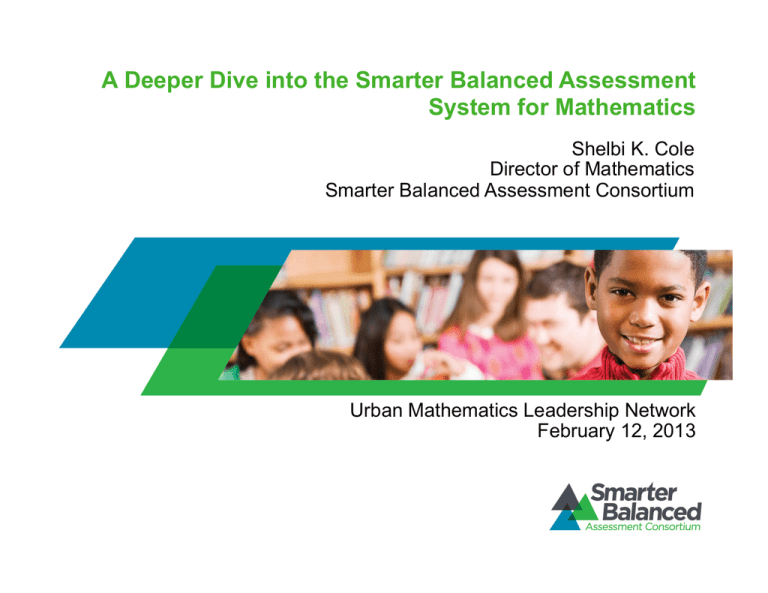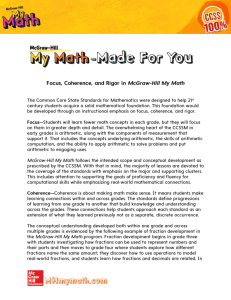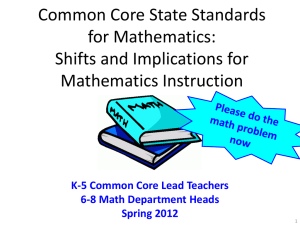A Deeper Dive into the Smarter Balanced Assessment System for Mathematics
advertisement

A Deeper Dive into the Smarter Balanced Assessment System for Mathematics Shelbi K. Cole Director of Mathematics Smarter Balanced Assessment Consortium Urban Mathematics Leadership Network February 12, 2013 "The world is small now, and we're not just competing with students in our county or across the state. We are competing with the world," said Robert Kosicki, who graduated from a Georgia high school this year after transferring from Connecticut and having to repeat classes because the curriculum was so different. "This is a move away from the time when a student can be punished for the location of his home or the depth of his father's pockets." Excerpt from Fox News, Associated Press. (June 2, 2010) States join to establish 'Common Core' standards for high school graduation. Common Core State Standards • • • Define the knowledge and skills students need for college and career Developed voluntarily and cooperatively by states; more than 40 states have adopted Provide clear, consistent standards in English language arts/literacy and mathematics Source: www.corestandards.org A Balanced Assessment System Common Core State Standards specify K-12 expectations for college and career readiness Summative assessments Benchmarked to college and career readiness Teachers and schools have information and tools they need to improve teaching and learning Teacher resources for formative assessment practices to improve instruction Interim assessments Flexible, open, used for actionable feedback All students leave high school college and career ready K-12 Teacher Involvement • Support for implementation of the Common Core State Standards (2011-12) • Write and review items/tasks for the pilot test (2012-13) and field test (2013-14) • Development of teacher leader teams in each state (2012-14) • Evaluate formative assessment practices and curriculum tools for inclusion in digital library (2013-14) • Score portions of the interim and summative assessments (2014-15 and beyond) Higher Education Collaboration • Involved 175 public and 13 private systems/institutions of higher education in application • Two higher education representatives on the Executive Committee • Higher education lead in each state and higher education faculty participating in work groups • Goal: The high school assessment qualifies students for entry-level, creditbearing coursework in college or university Timeline Formative Processes, Tools, and Practices Development Begins Summative Master Work Plan Developed and Work Groups Launched Procurement Plan Developed Writing and Review of Pilot Items/Tasks (including Cognitive Labs and Small-Scale Trials) Content and Item Specifications Development Writing and Review of Field Test Items/Tasks (throughout the school year) Pilot Testing of Summative and Interim Items/Tasks Conducted Field Testing of Summative and Interim Items/Tasks Conducted Preliminary Achievement Standards (Summative) Proposed and Other Policy Definitions Adopted Final Achievement Standards (Summative) Verified and Adopted Operational Summative Assessment Administered The Mathematics What is Changing? 8 Claims for the Mathematics Summative Assessment Overall Claim for Grades 3-8 Overall Claim for Grade 11 “Students can demonstrate progress toward college and career readiness in mathematics.” “Students can demonstrate college and career readiness in mathematics.” Claim #1 - Concepts & Procedures “Students can explain and apply mathematical concepts and interpret and carry out mathematical procedures with precision and fluency.” Claim #2 - Problem Solving “Students can solve a range of complex well-posed problems in pure and applied mathematics, making productive use of knowledge and problem solving strategies.” Claim #3 - Communicating Reasoning “Students can clearly and precisely construct viable arguments to support their own reasoning and to critique the reasoning of others.” Claim #4 - Modeling and Data Analysis “Students can analyze complex, real-world scenarios and can construct and use mathematical models to interpret and solve problems.” The CCSS Require Three Shifts in Mathematics • Focus strongly where the standards focus • Coherence: Think across grades and link to major topics within grades • Rigor: In major topics, pursue conceptual understanding, procedural skill and fluency, and application with equal intensity Slide 10 Shift #1: Focus Strongly where the Standards Focus The shape of math in A+ countries Mathematics topics intended at each grade by at least twothirds of 21 U.S. states Mathematics topics intended at each grade by at least twothirds of A+ countries 1 Schmidt, Houang, & Cogan, “A Coherent Curriculum: The Case of Mathematics.” (2002). Slide 11 Shift #1: Focus Key Areas of Focus in Mathematics Focus Areas in Support of Rich Instruction and Grade Expectations of Fluency and Conceptual Understanding K–2 Addition and subtraction - concepts, skills, and problem solving and place value 3–5 Multiplication and division of whole numbers and fractions – concepts, skills, and problem solving 6 Ratios and proportional reasoning; early expressions and equations 7 Ratios and proportional reasoning; arithmetic of rational numbers 8 Linear algebra and linear functions Slide 12 Shift #1: Focus Content Emphases by Cluster The Smarter Balanced Content Specifications help support focus by identifying the content emphasis by cluster. The notation [m] indicates content that is major and [a/s] indicates content that is additional or supporting. Slide 13 Shift #2: Coherence Think Across Grades, and Link to Major Topics Within Grades • Carefully connect the learning within and across grades so that students can build new understanding on foundations built in previous years. • Begin to count on solid conceptual understanding of core content and build on it. Each standard is not a new event, but an extension of previous learning. Slide 14 Shift #2: Coherence Think Across Grades Example: Fractions “The coherence and sequential nature of mathematics dictate the foundational skills that are necessary for the learning of algebra. The most important foundational skill not presently developed appears to be proficiency with fractions (including decimals, percents, and negative fractions). The teaching of fractions must be acknowledged as critically important and improved before an increase in student achievement in algebra can be expected.” Source: Final Report of the Na4onal Mathema4cs Advisory Panel (2008, p. 18) Slide 15 Coherence: Some Standards from Early Grades are Critical Through Grade 12 1.OA.7 Understand the meaning of the equal sign, and determine if equations involving addition and subtraction are true or false. For example, which of the following equations are true and which are false? 6 = 6, 7 = 8 – 1, 5 + 2 = 2 + 5, 4 + 1 = 5 + 2. Slide 16 What it Looks Like in Grade 3 True or False: 3 x 8 = 20 + 4 50 ÷ 10 = 5 x 1 9 x 9 = 8 x 10 T F T F T F Slide 17 What it Looks Like in Grade 5 True or False: 1 1 3 1 ! = ! 2 3 6 3 2 1 3 1 ! = ! 2 3 6 3 Slide 18 What it Looks Like in Grade 8 Tell how many solutions: 3x + 17 = 3x + 12 Slide 19 What it Looks Like in High School X4 – 5x3 + x2 + 2x + 1 = Drag the correct expression to make a true equation. x3 + (x + 1)2 + X4 – 6x3 X4 – 3x3 + 2x3 + x2 + 2x + 1 X4 – 5x3 + x + x + 2x + 1 … Slide 20 Shift #3: Rigor In Major Topics, Pursue Conceptual Understanding, Procedural Skill and Fluency, and Application • The CCSSM require a balance of: § Solid conceptual understanding § Procedural skill and fluency § Application of skills in problem solving situations • Pursuit of all three requires equal intensity in time, activities, and resources. Slide 21 Shift #3: Rigor Solid Conceptual Understanding • Teach more than “how to get the answer” and instead support students’ ability to access concepts from a number of perspectives • Students are able to see math as more than a set of mnemonics or discrete procedures • Conceptual understanding supports the other aspects of rigor (fluency and application) Slide 22 Shift #3: Rigor Procedural Skill and Fluency • The standards require speed and accuracy in calculation. • Teachers structure class time and/or homework time for students to practice core functions such as single-digit multiplication so that they are more able to understand and manipulate more complex concepts. Slide 23 Shift #3: Rigor Required Fluencies for Grades K-6 Grade Standard Required Fluency K K.OA.5 Add/subtract within 5 1 1.OA.6 Add/subtract within 10 2 2.OA.2 2.NBT.5 Add/subtract within 20 (know single-digit sums from memory) Add/subtract within 100 3 3.OA.7 3.NBT.2 Multiply/divide within 100 (know single-digit products from memory) Add/subtract within 1000 4 4.NBT.4 Add/subtract within 1,000,000 5 5.NBT.5 Multi-digit multiplication 6 6.NS.2,3 Multi-digit division Multi-digit decimal operations Slide 24 How Can Assessments Deliver on the Promise of Focus, Coherence and Rigor? • FOCUS: Assessments focus where the standards focus. Major content represents the majority of points and problems on assessments. • COHERENCE: Assessments honor the coherence in the standards. Balance of tasks assessing individual standards and related standards within the context of the grade and, as relevant, the progressions. • RIGOR: Assessments reflect the rigor of the standards. Balance of tasks assessing conceptual understanding, procedural skill and fluency, and application of mathematics to solve problems. Slide 25 From the Progressions Fractions Example 1 The shaded area represents the fraction 3/2. Choose the figure below that represents 1. A B C D Fractions Example 2 The shaded area represents the fraction 3/2. Drag the figures below to make a model that represents 3. Each figure can be used more than once. Fractions Example 3 The shaded area represents the fraction 3/4. Choose the figure below that represents 1/2. A B C D Fractions Example 4 The shaded area represents the fraction 3/2. Drag the figures below to make a model that represents 3 x 3/2. A B C D Fractions Example 5 The shaded area represents the fraction 3/2. Drag the figures below to make a model that represents ½ x 3/2. Summative Assessment: Purpose, Benefits and Limitations Purpose • Accountability for K-12 at the state, district, school and classroom/teacher levels • Accurate Information about individual students’ achievement, growth over time, and (in 11th grade) readiness for college in English and math. Benefits • Far more sophisticated and comprehensive measure of student knowledge and skills than most existing K-12 accountability or placement exams. • Linked to known, high-quality content standards (Common Core). • Early warning for students not yet college ready. Limita2ons • Summative exams are not diagnostic in nature. • Will not measure readiness for advanced mathematics (Calculus) requiring 12th grade instruction. Slide 32 Summative Assessment: Two-pronged Approach Computer Adaptive Test • Assesses the full range of Common Core in English language arts/literacy and mathematics for students in grades 3-8 and 11 (interim assessments can be used in grades 9 and 10) • Measures current student achievement and growth across time, showing progress toward college and career readiness • Includes a variety of question types: selected response, short constructed response, extended construction response, technology enhanced Performance Tasks • Extended projects demonstrate realworld writing and analytical skills • May include online research, group projects, presentations • Require 1 to 2 class periods to complete • Included in both English language arts/literacy and mathematics assessments • Applicable in all grades being assessed • Evaluated by teachers using consistent scoring rubrics Slide 33 How CAT Works (Binet’s Test) Using Computer Adaptive Technology for Summative and Interim Assessments Increased precision Tailored for Each Student • Provides accurate measurements of student growth over time • Item difficulty based on student responses Increased Security • Larger item banks mean that not all students receive the same questions Shorter Test Length • Fewer questions compared to fixed form tests Faster Results Mature Technology • Turnaround time is significantly reduced • GMAT, GRE, COMPASS (ACT), Measures of Academic Progress (MAP) Slide 35 Constrained Computer Adaptive Test Put a point at the number 1. 0 2 4 3 0 0 3/2 0 3/5 36 Constrained Computer Adaptive Test (cont.) Put a point at 3/5. 0 1 The computer adaptive test will have constraints that ensure that students receive comparable content in the test event. Slide 37 Smarter Balanced Sample Items http://sampleitems.smarterbalanced.org/ itempreview/sbac/ Slide 38 Key Talking Points for Item 43083: The Contest • This is a “line item” that shows how the content of grade 3 progresses up to grade 4, from multiplication and division within 100 to understanding the factors of a number and interpreting the remainder in a division problem Part C: How many four-eyed space creatures are needed to make a group with 24 total eyes? (grade 3) Part D: Somebody told the five-eyed space creatures that they could not join the contest. Explain why five-eyed space creatures cannot make a group with 24 total eyes. Slide 39 Key Talking Points for Item 43328: Fractions 2a • • • This item is one of a set of four in the domain “Fractions” across grades 3-5 Although part of the focus of this item is on operations with fractions (either multiplication of a mixed number by whole number or addition with mixed numbers), the response format asks students to “understand” that the resulting number is between two whole numbers, which is a more global goal of the standards in this domain Although the item has text with it, the set-up allows for students to easily understand what it is asking them to do, a nice feature for assessing mathematics of struggling readers and English Learners Slide 40 Key Talking Points for Item 42933: Calculator • • This item maps the 21st century onto the standards, acknowledging that students use apps, applets, and other tools – and determining whether these tools are functioning (or calculating) as intended is a critical skill This item type will be very useful in assessing students ability to create explicit formulas based on input and resulting output (while giving the student some control over the input) Slide 41 Key Talking Points for Item 42968: Water Tank • • • This item allows some student choice in how much water is moved from Tank A to Tank B to derive the radius of Tank B. The set-up allows students to deduce what is being asked even if they struggle to read the item text The item draws on the content of earlier grades, but calling for more sophisticated use of that mathematics Slide 42 Key Talking Points for Item 43057: Room Wall • • The animation shows how the relationship between slope and angle measure (using slope to determine congruence) is used in real life, a concept that would be difficult to portray with a static image This item attempts to push the field forward in terms of response capture and scoring capabilities Slide 43 Find Out More Smarter Balanced can be found online at: SmarterBalanced.org Slide 44





